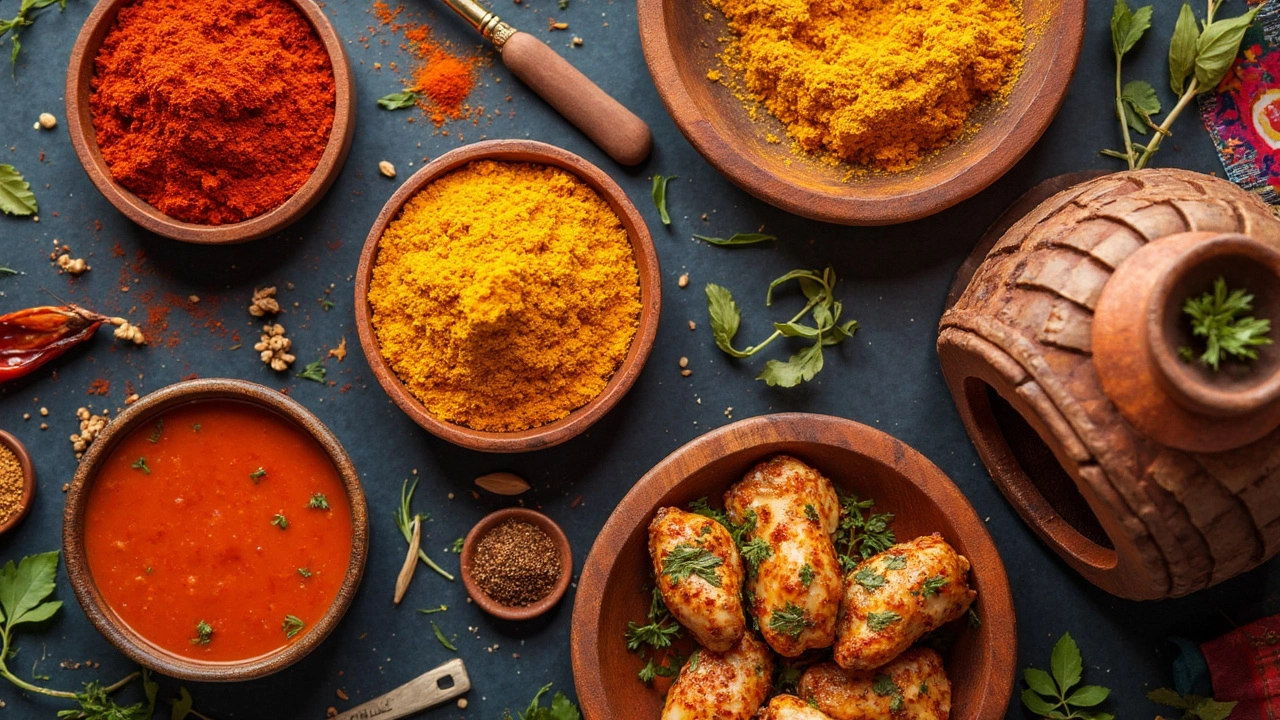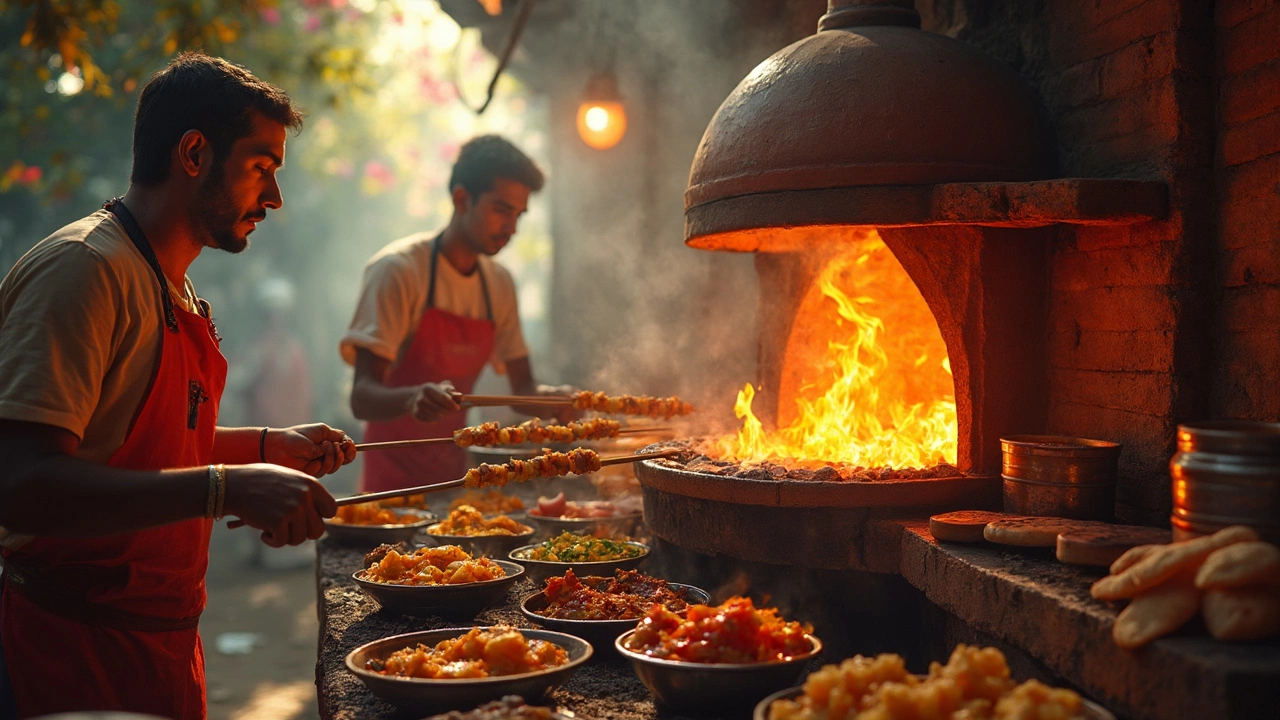You see the word 'tandoori' all over Indian menus, from sizzling chicken to smoky naan. But what exactly is it—just the spice blend, or is there an actual oven behind it? This simple-looking question can leave even food lovers puzzled. Some think it’s just the bright red seasoning clinging to juicy chicken legs. Others picture the towering, charcoal-fired oven that’s half as hot as a volcano. The word gets tossed around in recipes and restaurants, but hardly anyone slows down to talk about what 'tandoori' truly means or where it even comes from.
Tracing the Roots: What Exactly is a Tandoor?
If you’ve eaten Indian food, odds are good you’ve heard the word 'tandoor', even if you never saw one in real life. Picture a giant clay vase, open at the top, with glowing charcoal at the bottom. That’s your tandoor—a centuries-old oven that’s powered not by knobs or wires but by fire itself. The tandoor came from Central Asia and landed in India thousands of years ago, showing up in old writings from the Indus Valley civilization. Some believe those ancient clay ovens are what gave rise to the modern tandoor we know now.
These ovens are simple yet brilliant: shaped like a barrel, they trap heat way better than a regular kitchen oven. Imagine slapping bread dough directly onto the screaming hot inside wall—seconds later, you get naan or roti, crisp on one side, soft on the other, and smoky from the fire below. Chefs thread marinated meats onto long metal skewers and plunge them right over the coals, getting meat that sears on the outside but stays juicy within, picking up that unmistakable char and aroma that only a tandoor can deliver. Think of it as a supercharged barbecue meets brick pizza oven, but vertical instead of horizontal.
In homes, hotels, and roadside dhabas from Delhi to Lahore, tandoors are everywhere, each slightly different but all meant to lock in moisture and flavor. Some are squat, portable metal versions for backyards, but most keep to the ancient circular shape. Tandoori cooking isn’t about a tech gadget—it’s more like harnessing a wild, primitive fire and dancing around it with food. The best part? Even if you don’t have a tandoor at home, understanding its role makes every bite of 'tandoori' food more meaningful.
What’s In a Name? Tandoori Isn’t Just a Spice
This is where things get messy, and food labels don’t help. Yes, you can buy 'tandoori spice' at grocery stores, but that’s only part of the story. In India and Pakistan, 'tandoori' refers to anything cooked in a tandoor—so 'tandoori chicken' means chicken cooked in a tandoor, not chicken dusted with a certain seasoning (even if the spices are front and center).
Now, the tandoori masala—the red, bold spice mix—usually shows up in these dishes. This masala blends earthy cumin, smoky paprika, pungent garlic, punchy ginger, and a splash of red chili powder. Turmeric, coriander, and fenugreek might join. Some recipes add dried mango powder for tang. The fierce red color? That usually comes more from food coloring than chilies in restaurants, though Kashmiri chili does give a lovely hue without the heat.
The masala became popular as Indian restaurants needed a quick way to deliver that classic flavor, especially in the West. It’s easy to slap 'tandoori spice' on a chicken breast and call it tandoori—even if there’s never a clay oven in sight. But traditionalists will tell you: tandoori isn’t truly about the spice. It’s about the style, the smoke, the oven. The masala just helps bridge the gap for kitchens without a real tandoor.
Curious about trying it at home? Your broiler or grill can get close. Set it really hot, marinate your protein in yogurt and tandoori masala (store-bought or homemade), and cook quickly over high heat. It won’t be quite the same as a clay oven fired with charcoal, but you’ll get a taste of why this method rocks.

Tandoori in Practice: Beyond Chicken and Naan
If the first thing you think of is fiery tandoori chicken, you’re not alone. But the tandoor’s power goes far beyond poultry. Vegetarians won’t miss out, since tandoori paneer (a dense farmer cheese) soaks up all those smoky flavors, while cauliflower and mushrooms turn into charred bites worth fighting over. In northern India, seekh kebabs (minced meat on skewers) get their grill marks right here.
Breads play a starring role, and the process is pure food theater. A baker stretches out a lump of dough, flips it with a slap, smears water on the back, then presses it to the tandoor’s scorching inner wall. Seconds later, the bread puffs, blisters, and lifts off with a hook, all steamy and spotted with char. You can’t beat the drama—or the taste.
People also cook potatoes, fish, even fruit like pineapple in tandoors, especially for parties. Tandoori cooking works fast—meals can be ready in minutes, making it perfect for crowds. The high, dry heat sears and caramelizes, while the smoky fire stamps every bite with flavor that home ovens can only dream of copying.
Trying it yourself? Here’s a trick: line a charcoal grill with bricks to trap heat, or try a pizza stone in a super-hot oven. Marinate your veggies or protein overnight with yogurt, lemon, and plenty of tandoori spice for tenderness and color. For bread, keep the dough moist and be bold—slap it straight onto your grill grate for pockets and char.
Keep in mind—tandoori cooking doesn’t drown food in oil or cream, which is part of why those dishes taste lighter and spicier than some heavier Indian curries. If you’re after that signature smokiness at home, toss a hot lump of charcoal into a small dish, drizzle over a little ghee, and cover the plate of finished food briefly to infuse it with real smoke. Pro tip: Mix your own tandoori masala for more control. Store leftovers in an airtight jar, and you can flavor up plain vegetables, grilled meats, or even popcorn for a quick tandoori twist.
Tips, Trivia, and Tandoori Myths Busted
Here’s a fun fact—one of the earliest written descriptions of something like a tandoor comes from Persian and Central Asian sources more than 5,000 years ago. When the Mughal empire spread across South Asia, royal chefs took the tandoor to new heights, inventing dishes that are staples now. There’s an old legend that Mughal emperor Jahangir loved tandoori chicken so much, he’d travel with a portable tandoor.
People often think you need a giant clay oven to get 'tandoori' results. Not true—you can get surprisingly close using the right techniques. The crucial trick is high heat and short cook times, so the surface chars quickly and the inside stays moist. If you want extra authenticity, skip the food coloring. Use Kashmiri chili powder for a reddish hue without the artificial look. And always let proteins marinate in yogurt, which tenderizes and carries all those spices deeply into the food.
Don’t fall for the myth that all tandoori food must be fiery hot. Spiciness depends entirely on the cook—the real star is that interplay of smoke, tang, and char. Modern tandoors can use gas or even electric heating coils, but many purists chase that old-school, wood-fired taste.
If you’re out at a restaurant and the menu says ‘tandoori,’ look past just the spice mix. Ask how it’s cooked. Is it actually made in a tandoor? You might even request a seat near the open kitchen to watch the action. There’s magic in seeing naan thrown against a blazing oven wall or chicken emerging with blackened edges and sizzling juices.
Got kids or tandoori newbies in your house? Try tandoori vegetables or paneer first—flavorsome, not overpowering. For adventurous eaters, wrap marinated shrimp in foil and char them on the grill. And never underestimate the wow factor of homemade tandoori naan served warm with a brush of ghee and a sprinkle of sea salt.
- Real tandoori flavor comes from clay ovens, not just spice mixes.
- Tandoori spice blends are great shortcuts but don’t skip the smoky heat if you can help it.
- Marinate your food in yogurt-based blends for super-tender bites.
- Try veggies, tofu, and bread for endless tandoori options—chicken is just the beginning.
- Add a touch of smoky aroma using a simple charcoal smoke trick if you can’t access a tandoor.
So next time someone asks if tandoori is a 'spice' or an 'oven,' you can smile and say—it's both, and a whole lot more. The history, the taste, the fire—each bite brings a little piece of one of the world’s oldest and most beloved cooking methods right to your table. And that’s way hotter than any spice jar on its own.
